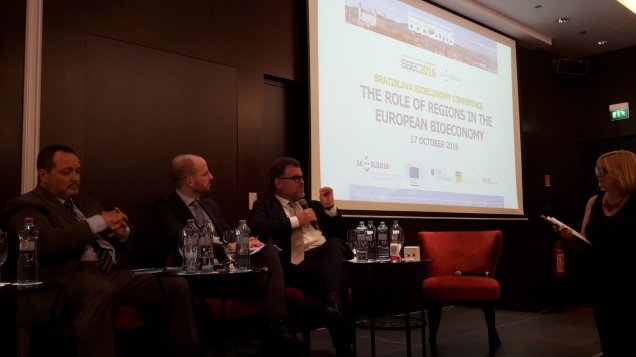
Another brick towards the European Bioeconomy, starting from regions. The European Commission together with the Slovak Presidency, and under the auspices of Standing Committee of Agricultural Research (SCAR), organised today in Bratislava a conference on the role of EU regions in developing a sustainable European Bioeconomy. The aim of the conference was “to discuss with national and regional stakeholders the new bioeconomy context for the agriculture, forestry and fisheries, the role of research and innovation to overcome the big societal challenges ahead of us and also to identify the barriers in the regions in adapting the bioeconomy strategy”.
In the Slovak capital, the EU bioecomy regions brought to the attention of EU policy makers the regional and international aspects of the Bioeconomy. The Conference was focused on how to integrate the concept of the regional bioeconomy into European policies, fostering stronger policy coordination in a top-down approach at national, regional and local level, in light of the EU 2020 strategy, the Horizon 2020 overarching goal and the Smart Specialization Strategy.
“The role of regions in the bioeconomy says Philippe Mengal, director of Biobased Industries JU – is to connect people, connect communities (farmers, industries, etc)”.
“A succesful regional bioeconomy needs to be rooted in a long-term common overarching vision shared by all relevant actors”, says Marc Palahí, director of European Forest Institute.
Bratislava hosted experts and a wide range of stakeholders from industry, academia and end-users to discuss about the routes to close the industrial research-market gap and maximize the knowledge-based development potential of local regions in the following bioeconomy key areas: Primary Production, the role of agriculture, forestry and marine resources; Agro-food by-products and waste as additional biomass sources; Horizontal key elements needed for a strong Bioeconomy in Europe; Innovation and key supporting measures; Implementation tools at regional level.
The aim of Bioeconomy Strategy is to shift the European economy towards greater and more sustainable use of renewable resources to ensure a secure and healthy food and feed supply, as well as producing bio-based materials, energy, and other products.
This will enable a more innovative and low-emissions economy – reconciling demands for sustainable agriculture and fisheries, food security, and the sustainable use of renewable biological resources for industrial purposes, while ensuring biodiversity and environmental protection.
As stated by John Bell, director Bioeconomy at the European Commission, “the bioeconomy is about sustainability and circularity. It is happening around the world and is a major opportunity for regions”.
Source
Supplier
Share
Renewable Carbon News – Daily Newsletter
Subscribe to our daily email newsletter – the world's leading newsletter on renewable materials and chemicals














